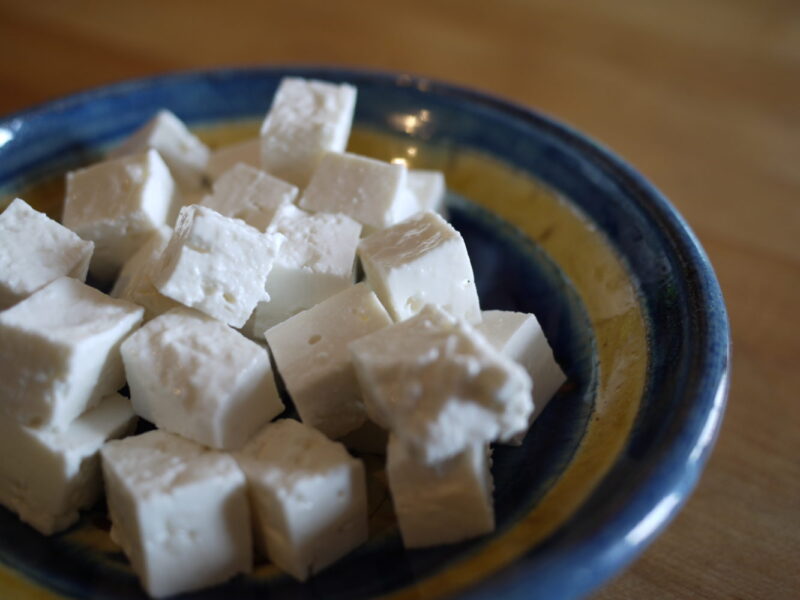Feta of Greece is indisputably “the” Greek cheese. Its name immediately brings to mind all the tastes we love, that we associate with Greece: the salad horiatiki (literally “village salad”, the famous Greek salad), the tyropita (cheese turnover), spanakopita (spinach and cheese turnover), tyrokaftéri (spicy cheese sauce), feta with honey and sesame (see recipe below).
You’ll be amazed at how much feta cheese the Greeks buy! The national cheese is always present at the daily or festive meal, placed in the middle of the table and seasoned with olive oil and oregano. It also accompanies vegetable dishes, known as “ladera”. Indeed, Greeks are accustomed to eating vegetarian meals at least twice a week, and cheese provides the necessary protein supplement.
A cheese that dates back to Homer
In the Odyssey, the Cyclops Polyphemus, son of Poseidon, lived with his brothers on a Mediterranean island, where he practiced the antediluvian trade of shepherd. He made a fresh cheese from his sheep’s milk, described in some detail by Homer. Was it feta? Only Ulysses could tell us. At least in Greece, we like to think that the famous Cyclops was the inventor!
Since then, methods and know-how have evolved. In 1996, the European Union recognized Greek feta as a cheese with a protected designation of origin (PDO). A controversy immediately broke out in many countries, including France, which marketed equivalent cheeses, usually made from cow’s milk. In 2002, the European Court of Justice ruled that feta is a cheese made only in mainland Greece and on the islands of Lesbos and Kefalonia, according to precise traditional methods. The war was over!

Feta in a barrel or a tin?
“Feta” literally means “slice” in Greek, probably because it was sliced before maturing. Made exclusively from ewe’s milk, it may contain goat’s milk in quantities of less than 30%. Its fat content does not exceed 25%. In any case, no real feta contains cow’s milk!
In Greece, there are so many different kinds of feta that it could be given several different names. However, there are two main categories:
- Feta matured in oak barrels, called varélissia. It has a spicier, peppery taste. The ones at Kalavrita, Kefalonia and Tripoli are famous.
- Feta preserved in tin cans, tenekès, such as Dodoni or Ipiros. The taste of milk is more pronounced in this category.
Which is the best? It’s up to each individual to choose, but the Greeks are adamant about “their” feta! A large number of Greek cheeses resemble feta, but they are variants, sometimes with protected designations: the sféla (local cheese from Messinia in the Peloponnese), the telemetry (in a soft metal can), the kalathaki from Limnos (drained in a small wicker basket, which gives it its characteristic shape), the gidino (made with goat’s milk only).
Where can I buy feta?
- In Greece: everywhere, in grocery stores and supermarkets. You can ask to taste it before you buy. Personally, for the “varéli” (barrel) version, I often choose KALAVRITA feta. Otherwise, my favorite is DODONI, from Epirus, soft and creamy. In supermarkets, you’ll find feta in 400gr packs. But I advise you to prefer the cut version, as the fragrances are better preserved. Once purchased and opened, feta can be stored for 1 week in a cool place. It can also be frozen and taken out of the freezer a few hours before eating!

Recipe for Feta in a honey-sesame filo pastry crust
For a mezze for 2 -3 people
- 1 100gr slice feta cheese
- A little flour
- 1 sheet of filo pastry, alternatively 1 sheet of brick pastry
- Greek honey with thyme or other liquid honey, approx. 1 tablespoon
- Mixture of white sesame and black cumin, approx. 1 tablespoon
- Mixture of olive oil and sunflower oil for frying
Dredge the cheese in the flour and remove any excess. Place it on the end of the filo pastry and roll up, so that the cheese is completely trapped in the pastry.
Heat about 5mm of oil in a small frying pan. You can use just vegetable oil, but it’s much better with an olive oil blend. Lower the heat to medium, then place the cheese in the oil and brown on both sides. Remove and place on absorbent paper. Without delay, move the feta to the serving dish, drizzle generously with honey, sprinkle with the sesame-nigella mixture and serve immediately.
You can also prepare individual portions and serve as a starter with a green salad.
Evi P.
*****




